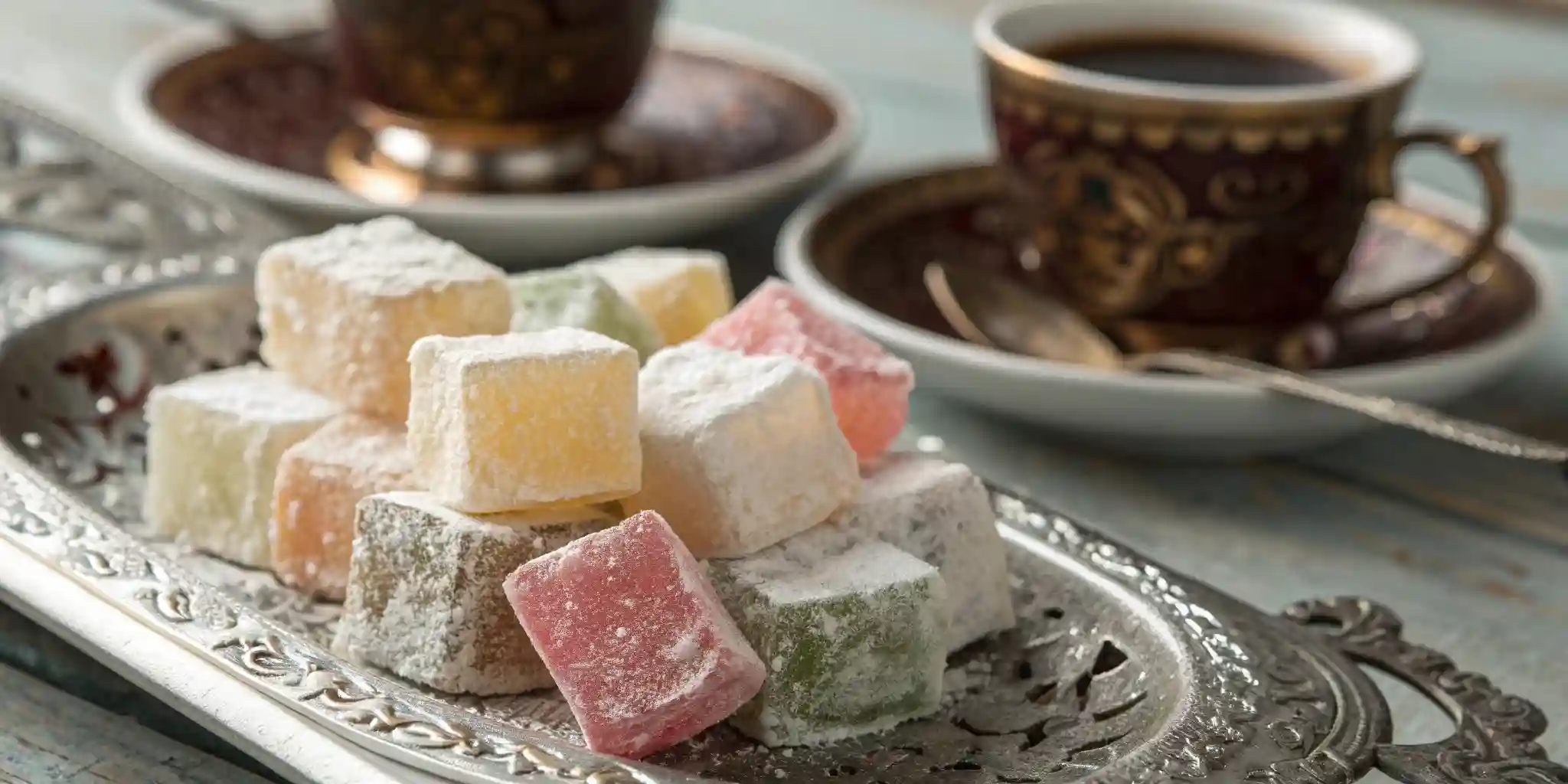Turkish Delight was one of those desserts that took me by surprise. You know the kind—unexpected, a little mysterious, and somehow… comforting.
It instantly took me back to that quiet dinner during my pregnancy—the one that lit the spark. Back then, cravings ruled my life, and every dessert felt like a tiny lifeline. But that night, it wasn’t Red Velvet. It was something else. Delicate. Chewy. Lightly floral. It was Turkish Delight, and it felt like home in a candy.
I’m Maya—and what started as a craving quickly became an obsession to recreate the magic. Thirteen batches (and a few powdered sugar disasters) later, I finally nailed it. This isn’t just candy—it’s a cultural treasure, a love letter to Ottoman kitchens, and a total game-changer for anyone who craves both comfort and elegance in their desserts.
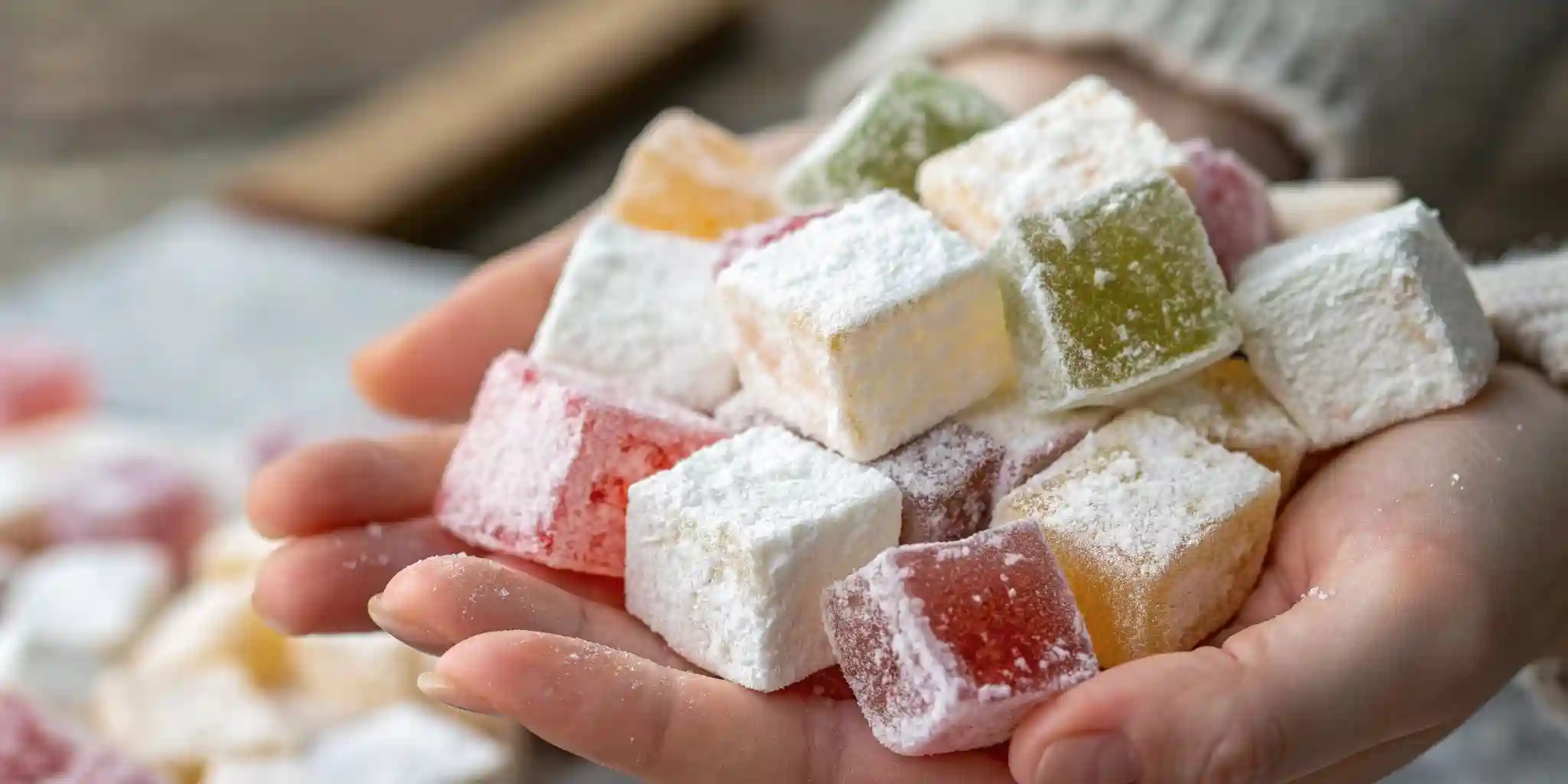
In this guide, I’ll walk you through everything—history, ingredients, and the foolproof recipe that made me fall in love with lokum all over again.
Table of Contents
What Is Turkish Delight Made Of? (Ingredients Explained)
Traditional Ingredients in Authentic Turkish Delight
At its heart, Turkish Delight is beautifully simple—just sugar, water, cornstarch, and a touch of citric acid or lemon juice. That’s all it takes to create those soft, chewy cubes we know and love. No gelatin. No preservatives. And yes, it’s naturally vegan and gluten-free.
The magic happens when sugar syrup and cornstarch slowly transform together, creating a smooth, elastic texture that’s unmistakably lokum. In Ottoman kitchens, this was done by intuition; today, we use thermometers—but the soul of the process remains the same.
Print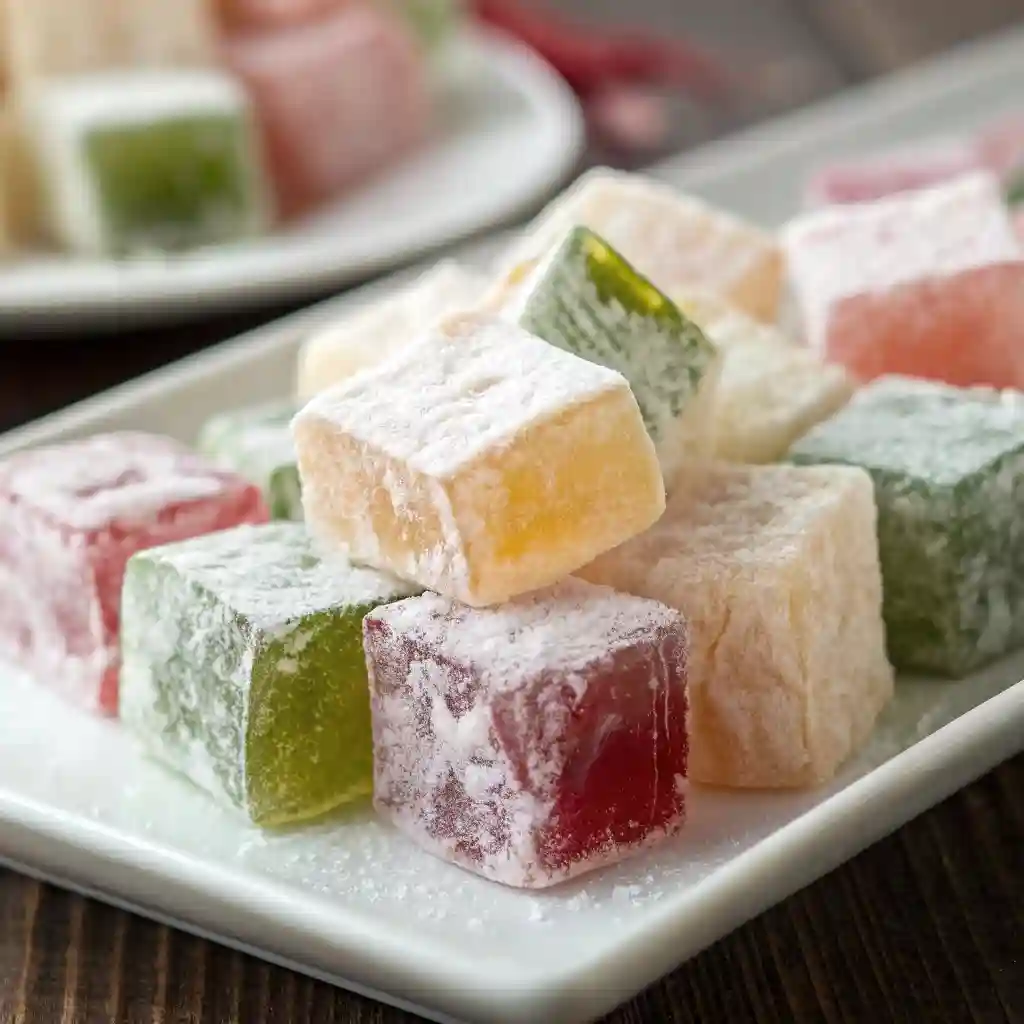
Turkish Delight – The Ultimate Guide to Authentic Lokum History, Recipe & Secrets
- Total Time: 7 hours
- Yield: 64 pieces 1x
- Diet: Vegetarian
Description
A sweet, chewy treat made from starch and sugar, Turkish Delight is a classic Middle Eastern confection often flavored with rosewater, lemon, or orange blossom and dusted with powdered sugar.
Ingredients
4 cups granulated sugar
1 cup cornstarch
1 tsp cream of tartar
4 ½ cups water
1 tbsp lemon juice
1 ½ tbsp rosewater (or orange blossom water)
Red or pink food coloring (optional)
1 cup powdered sugar (for dusting)
½ cup chopped pistachios or hazelnuts (optional)
Instructions
1. Grease an 8-inch square pan and line it with parchment paper.
2. In a saucepan, combine sugar, lemon juice, and 1 ½ cups water. Bring to a boil over medium heat until it reaches 240°F (soft-ball stage).
3. In another pot, mix cornstarch, cream of tartar, and 3 cups water. Whisk constantly over medium heat until thick and gluey.
4. Slowly pour the hot sugar syrup into the starch mixture, stirring constantly.
5. Simmer the combined mixture over low heat for 1 hour, stirring frequently to avoid burning.
6. Stir in rosewater, food coloring, and optional nuts, then pour into the prepared pan and let set for 6+ hours or overnight.
7. Once firm, cut into cubes and toss in powdered sugar to coat.
8. Store in an airtight container at room temperature with layers separated by wax paper.
Notes
Use a candy thermometer to avoid overcooking.
You can swap rosewater with orange blossom for a different flavor.
Avoid humidity for best results when storing.
- Prep Time: 15 minutes
- Cook Time: 1 hour
- Category: Dessert
- Method: Stovetop
- Cuisine: Middle Eastern
Nutrition
- Serving Size: 2 pieces
- Calories: 130
- Sugar: 25g
- Sodium: 5mg
- Fat: 1g
- Saturated Fat: 0g
- Unsaturated Fat: 1g
- Trans Fat: 0g
- Carbohydrates: 32g
- Fiber: 0g
- Protein: 0g
- Cholesterol: 0mg
Keywords: Turkish Delight, Lokum, homemade candy
Modern Touches and Flavor Variations
Classic rosewater gives Turkish Delight its iconic floral aroma, but you’ll also find varieties flavored with orange, mastic, pomegranate, or packed with pistachios and hazelnuts. A little food coloring can create that rosy Narnia look, but the golden amber of natural sugar is just as stunning.
The key is balance—too much rosewater and it’s soapy, too little and it loses its charm. Get it right, and you’ve got a candy that’s both elegant and comforting.
Check out this fun twist like our Apple Blossom Dessert—because Turkish flavors love company.
How Does Turkish Delight Taste? A Flavor Journey
Texture, Flavors, and Mouthfeel of Lokum
Bite into Turkish Delight, and you’ll feel it before you taste it. The texture is soft but springy, with just enough chew to linger for a moment before melting away. It’s not sticky like caramel or stretchy like taffy—it’s its own thing entirely. Smooth, silky, and almost pillow-like, each cube dusted in powdered sugar feels like a little treasure.
The flavor depends on the variety, but the classic rosewater lokum is subtly floral—light, elegant, and sweet without being overpowering. Orange brings a sunny brightness, pomegranate adds tart depth, and nut-filled versions offer a satisfying crunch alongside the chew.
Popular Variants: Rose, Pistachio, Citrus & More
In Turkey, Turkish Delight isn’t just one flavor—it’s a whole spectrum of possibilities. The rose version is iconic, but pistachio-studded lokum has an earthy richness, while lemon is fresh and zesty. Mastic lends a piney, almost herbal quality that’s unlike any other candy.
Some confectioners mix flavors—think pomegranate-pistachio or orange-hazelnut—for a balanced bite that’s both familiar and surprising. No matter the choice, each piece is designed to be savored slowly, often alongside strong Turkish coffee.
Looking for inspiration? Try our delightful Pistachio Raspberry Cake—because pistachio deserves the spotlight beyond lokum.
Turkish Delight Recipe – Step-by-Step (From Narnia Edition)
Gathering Your Tools and Ingredients
Making Turkish Delight at home is less about fancy equipment and more about patience and precision. You’ll need:
- A sturdy saucepan that distributes heat evenly
- A reliable candy thermometer (temperature is your best friend here)
- A whisk for smooth mixing
- A heatproof dish or pan for setting the candy
- A sharp knife for clean cuts
And for the ingredients:
- White sugar
- Cornstarch
- Citric acid or fresh lemon juice
- Rosewater or another flavor you love
- Optional food coloring for that signature look
- Powdered sugar and cornstarch for coating
The Cooking Process
1. Make the sugar syrup. Combine sugar, water, and citric acid in your saucepan. Heat gently, then bring to a steady boil. Watch closely until the thermometer reads around 250°F, which gives Turkish Delight its ideal chew.
2. Prepare the starch mixture. In a separate container, whisk or shake cornstarch with water until no lumps remain.
3. Combine and cook slowly. Once your syrup reaches temperature, slowly whisk in the starch mixture. Reduce the heat and let it cook gently, stirring occasionally. This slow, steady simmer allows the starch to transform into that signature lokum texture.
4. Flavor and set. When the mixture becomes thick, glossy, and pulls slightly from the sides of the pan, remove from the heat. Stir in rosewater (and coloring if desired), pour into a lightly oiled dish, and smooth the surface. Leave it at room temperature for several hours, ideally overnight.
5. Slice and coat. Dust your work surface with the cornstarch–powdered sugar blend, turn out the candy, and cut into cubes. Roll each piece in more coating to keep them from sticking.
Helpful Hints for Perfect Results
- Keep your stirring gentle after thickening to preserve a smooth texture
- Don’t rush the simmer—flavor and chewiness both need time to develop
- Always let it cool completely before cutting, or you’ll end up with sticky, misshapen cubes
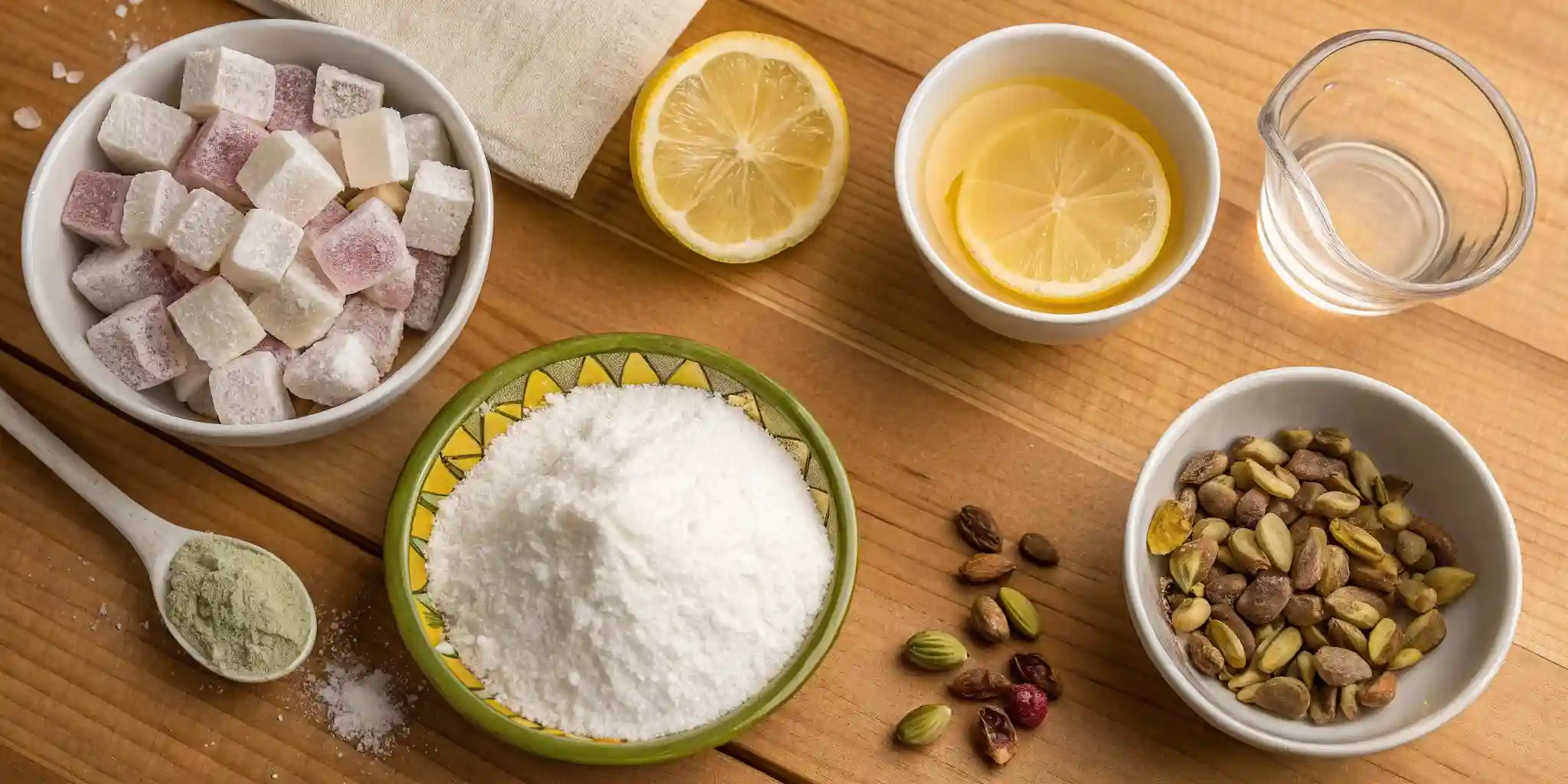
Check out this fun twist like our Apple Blossom Dessert—because Turkish flavors pair beautifully with fruity sweets.
Why Is Turkish Delight So Expensive? The Science Behind the Sweet
The Time and Skill Investment
At first glance, Turkish Delight might not seem like a luxury item—after all, it’s made from basic pantry staples. But the real cost isn’t in the ingredients—it’s in the time, precision, and skill it takes to make it right.
Unlike quick candies or cookies, lokum requires a slow, careful cooking process that can take up to two hours of constant attention. The sugar syrup must reach exactly the right temperature, and the cornstarch mixture has to be cooked gently so it transforms into that smooth, chewy texture. One degree too hot or too cold, and the entire batch can fail. That’s a lot of pressure for a single pan of candy.
Quality Ingredients Make a Difference
Authentic Turkish Delight also uses high-quality flavorings like pure rosewater, pistachios, or even rare mastic resin. These aren’t cheap, especially when sourced from traditional regions in Turkey where the best varieties are grown or produced. For nut-filled lokum, producers often use premium, double-roasted pistachios or hazelnuts—ingredients that instantly raise costs but dramatically improve flavor.
Small-Batch Tradition Over Mass Production
Many of the best lokum makers still work in small batches, using copper pans and wooden paddles, just as they have for generations. While mass-produced versions can be cheaper, they often lose the delicate balance of texture and flavor that makes real Turkish Delight so special. Paying a little more often means you’re getting a piece of edible history, not just sugar and starch pressed into cubes.
When you understand the patience, precision, and premium ingredients behind it, the price tag feels less like a splurge and more like a fair trade for something truly crafted with care.
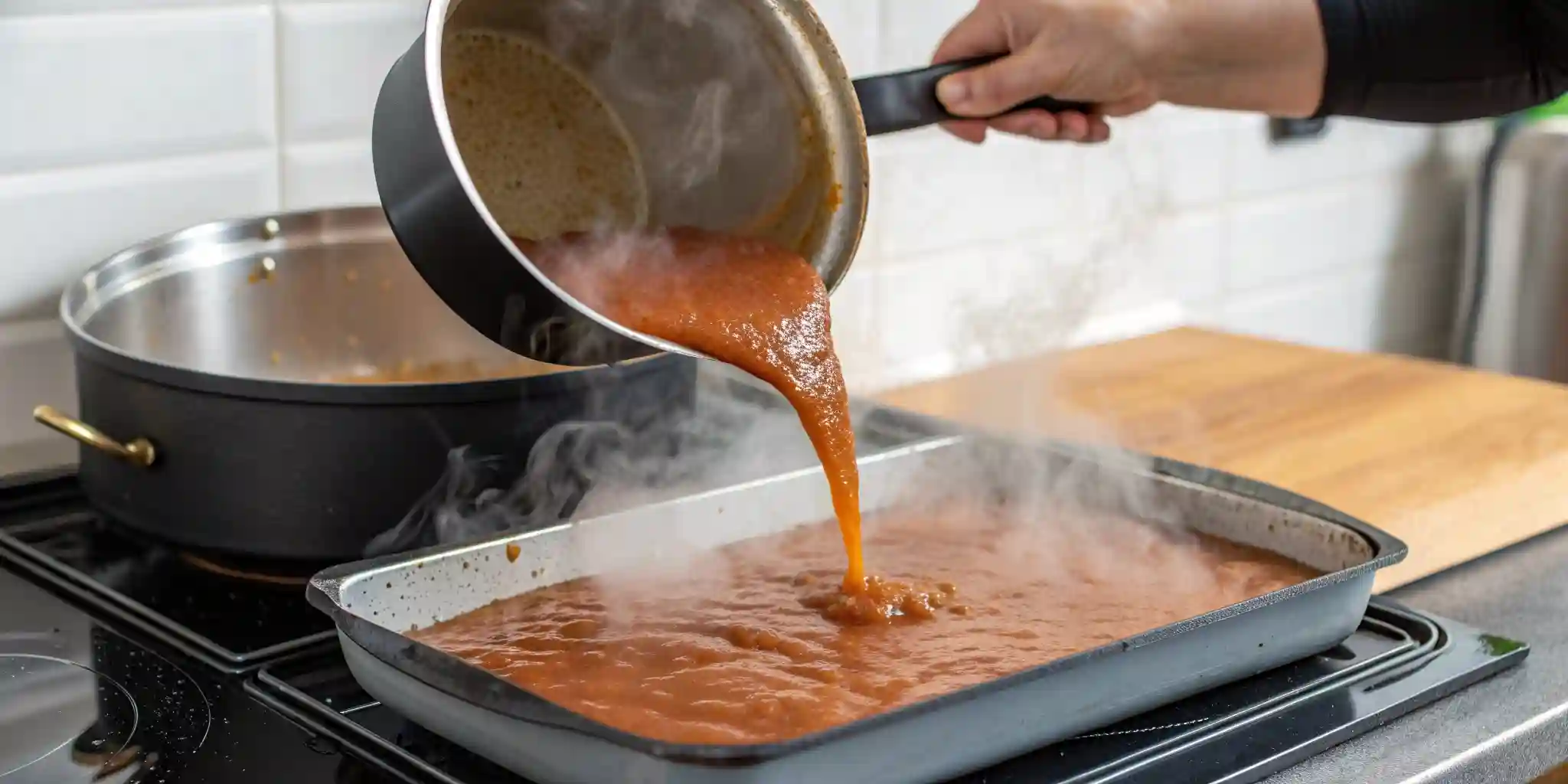
Discover great ideas like this in our Desserts collection—because every sweet has its own story.
What’s the American Version of Turkish Delight?
From Istanbul to Narnia to the U.S.
When most Americans first hear about Turkish Delight, it’s not from a candy shop—it’s from The Lion, the Witch, and the Wardrobe. C.S. Lewis gave lokum a starring role as Edmund’s irresistible temptation, and that single scene turned the sweet into a lifelong curiosity for many readers. In the U.S., the fascination began less with history and more with magic.
That literary moment created a wave of demand, but authentic Turkish Delight wasn’t widely available at the time. As a result, many early “American versions” were adapted to local tastes and ingredients, often swapping traditional rosewater for more familiar flavors like vanilla, lemon, or chocolate.
How Americans Adapt Lokum Today
In the U.S., you’ll find Turkish Delight in two main forms:
- Imported Authentic Lokum – usually from Turkish or Middle Eastern markets, keeping the original flavors intact.
- American-Style Versions – often softer, sometimes coated in chocolate, or flavored with berry extracts rather than floral waters.
Some specialty candy makers even turn lokum into a filling for truffles or layer it into cakes. While these variations stray from Ottoman tradition, they still celebrate the candy’s soft, chewy texture—just in a way that suits American palates.
The beauty is, both versions have their charm: the authentic for its cultural heritage, the American for its creativity. Either way, once you’ve tasted a truly well-made piece, you understand why Edmund didn’t stop at just one.
Looking for inspiration? Try our delightful Pistachio Raspberry Cake—because pistachio belongs in every dessert conversation.
How to Serve Turkish Delight Like a Local
With Turkish Coffee: A Perfect Pairing
In Turkey, Turkish Delight isn’t just a sweet—it’s part of a ritual. Traditionally, a few cubes are served alongside a small, strong cup of Turkish coffee. The bitterness of the coffee balances the candy’s sweetness, creating a harmony that feels both indulgent and refined. You take a sip, then a bite, letting the flavors mingle slowly.
For Guests and Celebrations
Offering lokum to visitors is more than hospitality—it’s a cultural gesture. In many homes, guests are welcomed with a small dish of Turkish Delight, often arranged beautifully in a glass or silver tray. Weddings, holidays like Bayram, and even casual gatherings often feature it as a sign of warmth and generosity.
Creative Modern Twists
While tradition holds strong, modern food lovers are finding new ways to enjoy lokum. Some sandwich it between buttery biscuits, while others chop it up and fold it into ice cream or use it as a cake filling. For gifting, elegant boxes filled with assorted flavors—rose, pistachio, orange—turn this humble candy into a thoughtful, luxurious present.
Whether served the old-fashioned way or reimagined for modern desserts, Turkish Delight remains more than a treat—it’s a shared experience.
Don’t miss our rich and crispy Xango Dessert—another indulgence worth sharing.
Storage & Shelf Life of Turkish Delight
Best Storage Practices to Preserve Texture
One of the great things about Turkish Delight is how well it keeps—if stored correctly. After making or buying it, place the cubes in an airtight container, layering them with parchment paper to prevent sticking. Always dust them lightly with a cornstarch–powdered sugar blend before storing; it’s the best shield against moisture.
For short-term storage, a cool, dry pantry works perfectly. Avoid direct sunlight and heat, which can cause the candy to sweat and lose its signature chewiness.
Refrigeration vs. Room Temperature
Most authentic Turkish Delight can last weeks at room temperature if kept dry, but refrigeration can extend its life for months—especially for varieties with nuts. Just be sure to bring it back to room temperature before serving so the texture stays soft and inviting.
If your lokum contains dairy, like clotted cream-filled varieties, refrigeration is a must, and the shelf life will be much shorter—just a few days.
Signs It’s Past Its Prime
Properly stored, lokum doesn’t spoil quickly, but it can lose its appeal. If it becomes overly hard, sticky, or develops an off smell, it’s time to make or buy a fresh batch.
Handled with care, this candy can be enjoyed slowly, allowing every bite to taste as perfect as the first.
Discover great ideas like this in our Desserts collection—because sweet moments deserve to last.
Other Authentic Turkish Desserts to Try
A Sweet World Beyond Lokum
While Turkish Delight holds a special place in the heart of Turkish cuisine, it’s only one chapter in a much bigger dessert story. Turkish sweets are as varied as they are flavorful, each with its own heritage and unique charm.
Must-Try Classics
- Baklava – Crispy layers of paper-thin pastry, brushed with butter, layered with nuts, and drenched in sweet syrup. It’s as rich as it is iconic.
- Kazandibi – A silky milk pudding with a caramelized base, giving it both a creamy and slightly chewy contrast in every spoonful.
- Zerde – Golden from saffron and fragrant with rosewater, this rice pudding is traditionally served at celebrations for good luck.
Hidden Treasures
- Pestil – Sun-dried fruit sheets, often layered with crushed nuts for a naturally sweet snack.
- Kabak Tatlısı – Tender pumpkin cooked slowly with sugar, then sprinkled with walnuts for a cozy, autumn-like flavor.
- Sambali – A nutty semolina cake soaked in syrup, perfect for anyone who loves dense, moist desserts.
Every one of these sweets shares something with Turkish Delight—a dedication to balance, texture, and a touch of indulgence. Together, they create a dessert table that tells the story of a culture through flavor.
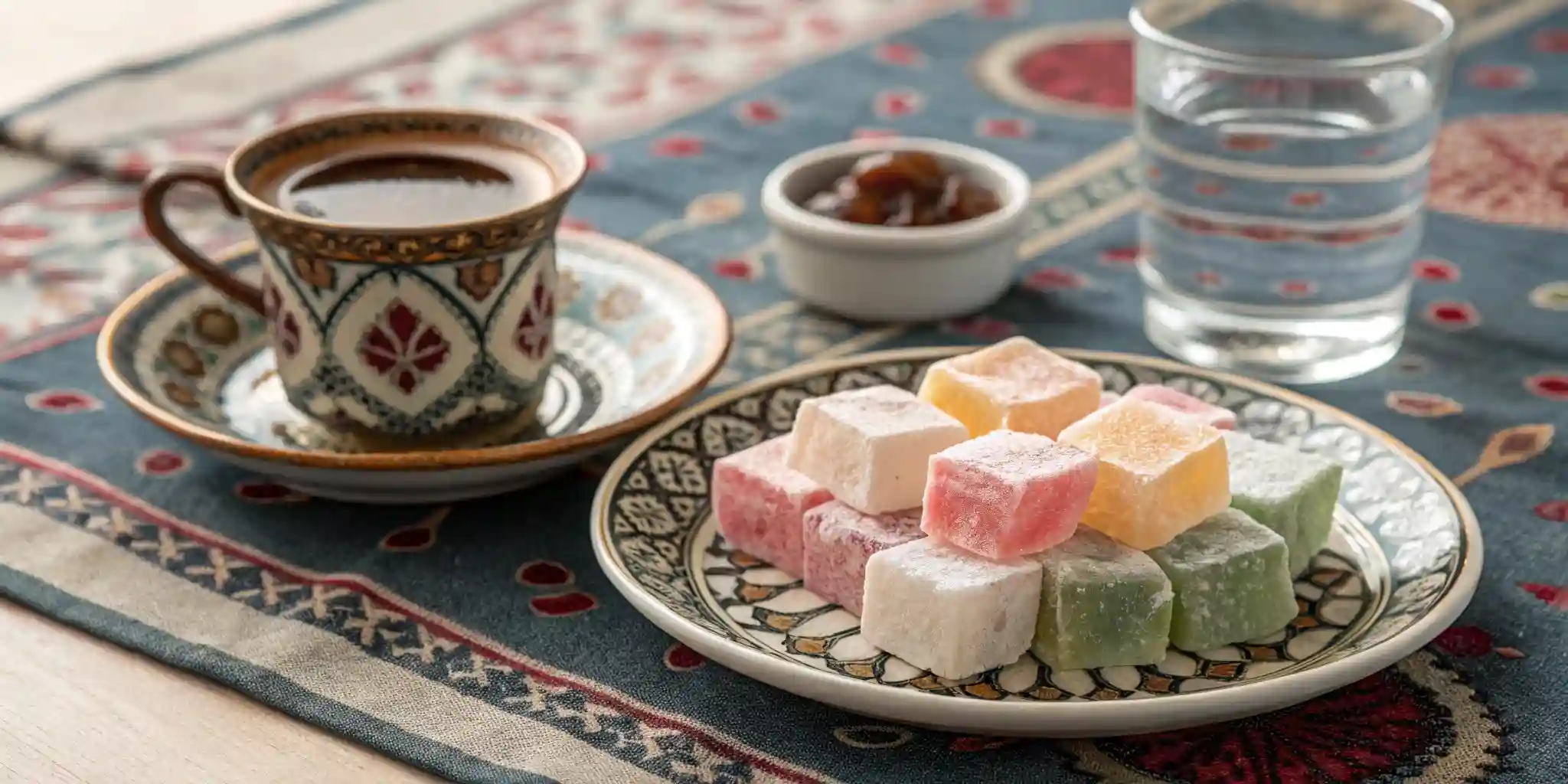
Looking for inspiration? Try our delightful Pistachio Raspberry Cake—because pistachio magic isn’t just for lokum.
Conclusion
Turkish Delight is more than a sweet—it’s a story told through flavor, texture, and tradition. From its origins in Ottoman kitchens to its role in literature and its place on modern dessert tables, lokum has remained a treat that connects people across time and culture.
Making it at home is a lesson in patience and precision, but it’s also deeply rewarding. With just a few simple ingredients, careful cooking, and the right balance of flavors, you can create something that feels luxurious yet comforting—whether you’re enjoying it with strong Turkish coffee, sharing it with guests, or giving it as a thoughtful gift.
Every bite carries a little history, a little craftsmanship, and a lot of joy. So the next time you dust your fingers with powdered sugar and savor that chewy, fragrant cube, remember—you’re tasting a tradition that’s been perfected over centuries.
Discover great ideas like this in our Desserts collection—because the sweetest moments are worth sharing.
What is a Turkish Delight made of ?
Authentic Turkish Delight is crafted from just a few simple ingredients—sugar, water, cornstarch, and a small amount of citric acid or lemon juice. These are slowly cooked together to create that smooth, chewy texture lokum is famous for. Many varieties also include flavorings like rosewater, orange blossom, or pomegranate, and some are studded with nuts such as pistachios or hazelnuts.
What is the American version of Turkish Delight?
In the U.S., you’ll find two main interpretations. One is imported, authentic Turkish Delight, usually sold in Middle Eastern markets. The other is an American-style adaptation, often flavored with berry extracts or coated in chocolate instead of traditional powdered sugar. Some candy makers even use lokum as a filling for truffles or baked goods.
What does Turkish Delight taste like?
The classic rosewater Turkish Delight has a light floral aroma balanced by a gentle sweetness. Its texture is soft and slightly chewy, somewhere between a marshmallow and a jelly candy. Depending on the variety, you might also taste bright citrus, earthy mastic, or the richness of roasted nuts.
Why is Turkish Delight so expensive?
The cost comes from the process and the quality of ingredients. Making Turkish Delight takes time, careful temperature control, and often small-batch craftsmanship. Premium ingredients like pure rosewater, high-grade pistachios, or rare mastic resin also raise the price. It’s a labor of love, and that care shows in every bite.
Did this dessert happen in your kitchen?
There are no reviews yet. Be the first one to write one.

